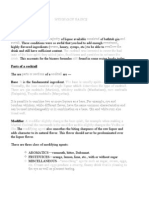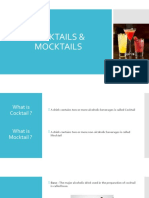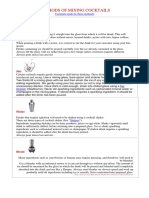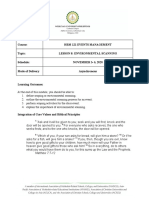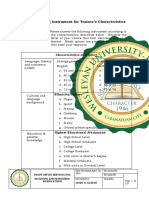Mixology (Part One)
Mixology (Part One)
Uploaded by
Cindy Ortiz GastonCopyright:
Available Formats
Mixology (Part One)
Mixology (Part One)
Uploaded by
Cindy Ortiz GastonOriginal Description:
Copyright
Available Formats
Share this document
Did you find this document useful?
Is this content inappropriate?
Copyright:
Available Formats
Mixology (Part One)
Mixology (Part One)
Uploaded by
Cindy Ortiz GastonCopyright:
Available Formats
Mixology
MIXOLOGY
is the art of following a recipe or
formula to produce a standard and
consistent drink according to
specification.
COCKTAIL
is a mixed drink made up of a base
liquor, modifying ingredients, flavoring
and coloring ingredients.
MOCKTAIL
is the collection of mixed
drinks which contains no
alcohol, also known as
virgin cocktails.
MIXED DRINK
includes any drink in
which alcoholic beverages
are mixed or added to one
or more alcoholic
ingredients.
Structure and Components of Mixed
Drinks
Each drink has a major alcoholic ingredient or base
(spirit), which determines its character and its
predominant flavor.
It has one or more complementary ingredients, which
modify or enhance that flavor.
The major ingredient is the base of the drink.
The modifiers and flavor accents make each drink
different from all others with the same base.
Developing Drink Recipes
A successful mixed drink:
relationship between the glass,
the ice, and
the drink ingredients.
Train bartenders to follow the recipes
consistently.
Ice is a key ingredient in the taste of any
drink made with a carbonated mix or fruit
juice.
Factors to consider when creating a drink:
1. Taste complexity overall sophistication
of the drink.
Commonplace
Tasty but artless
Inspiring
Challenging and complex
Factors to consider when creating a drink:
2. Degree of difficulty
Elementary
Basic
Moderate
Difficult
Advanced
Measuring
The only way to pour a drink that
follows recipe: measure every
ingredient.
Measuring Liquor:
Metered pour
Jigger
Free - pour
Mixing Methods
To BUILD
is to mix it step-by-step in
the glass in which it will be
served, adding ingredients
one at a time.
- the ingredients are floated
on top of each other, but
occasionally, a swizzle stick is
put in the glass, allowing the
ingredients to be mixed.
Mixing Methods
To STIR
- is to mix the ingredients
together by stirring them
with ice in a mixing glass,
then straining the mixture
into a chilled glass.
Purpose: to mix and cool the
ingredients quickly with a
minimum of dilution.
Mixing Methods
To SHAKE
- is to mix it by hand in a
shaker or using a
mechanical mixer.
- shake a drink if it contains
an ingredient that does not
readily mix with spirits
(sugar, cream, egg and fruit
juice).
Mixing Methods
To BLEND
- An electric blender is needed
for recipes containing fruit or
other ingredients which do not
break down by shaking.
- Blending is an appropriate
way of combining these
ingredients with others,
creating a smooth ready to
serve mixture.
Mixing Methods
LAYERING
- To layer or float an
ingredient on top of
another, use the rounded or
back part of a spoon and
rest it against the inside of
a glass.
Mixing Methods
MUDDLING
- To extract the most flavor
from certain fresh ingredients
such as fruit or mint
garnishes, you should crush
the ingredient with the
muddler on the back end of
your bar spoon, or with a
pestle
Mixing Methods
To STRAIN
- is to filter out ice and
other solids, leaving them
behind when you pour out
the liquid.
Drink Families
Mixed drinks are a lot like people. They have
structure, but within that structure are countless
variations.
Drink evolved in families.
Two keys to family character:
1. The ingredients
2. Method of mixing the drinks.
The HIGHBALL Family
HIGHBALL is a
mixture of a spirit and a
carbonated mixer or water,
served with ice in a highball
glass.
Examples:
Scotch and Soda
Gin and Tonic
Cuba Libre
FRUIT-JUICE DRINKS
Are first cousins to the highball family.
Major difference: fruit juice takes the
place of the carbonated mix as the
body of the drink.
Examples:
Screwdriver (Vodka, Orange juice)
Harvey Wallbanger (Vodka, Orange
juice, Galliano)
Tequila Sunrise (Tequila, Orange
juice, Grenadine)
Liquor on Ice
Another type of drink built in
the glass consist of a single
liquor served over ice;
nothing else is added.
Examples:
Scotch on the Rocks
Scotch Mist (Scotch, Lemon
twist)
TWO-LIQUOR DRINKS ON ICE
Combine a jigger of a major
spirit with a smaller amount of a
flavorful liqueur.
Examples:
Black Russian (Vodka, Kahlua)
Stinger (Brandy, Crme de
Menthe)
Rusty Nail (Scotch, Drambuie)
COLLINS FAMILY
Family Characteristics
Ingredients: Liquor, lemon juice,
sugar, soda, cube ice,
maraschino cherry.
Glass: Collins (12 to 14 ounces)
Mixing method: Build with
Collins mix
Collins Mix: A Sweet and sour
combination of lemon juice,
sugar and soda.
RICKEYS
Are cousins to the collinses. They
use lime instead of lemon and are a
shorter, drier drink. They are served
in a smaller glass and contain little or
no sugar.
Family Characteristics
Ingredients: Liquor, fresh lime, soda,
cube ice
Glass: Highball or Old-fashioned
Mixing Method: Build with Collins mix
COOLER
It was a typical long drink made with
liquor and soda or ginger ale and
served over ice in Collins glass
decorated with a long spiral of
lemon peel curling around inside
the glass from bottom to top.
Wine Cooler (Red wine, 7Up)
Spritzer (White wine, Soda, Lemon
Slice)
OLD-FASHIONED DRINKS
Two venerable drinks that
are still alive:
Old fashioned (Current)
(Whiskey, simple syrup,
angostura bitters, soda
water)
Mint Julep (Fresh mint,
simple syrup, bourbon)
POUSSE-CAFS
Coffee pusher
It is an old-fashioned after-dinner
drink.
Family Characteristics
Ingredients: liqueurs at different
densities, sometimes non-alcoholic
syrups, brandy, cream, or all of
these.
Glass: Straight-sided liqueur or brandy
glass
Mixing Method: Build (float)
COFFEE DRINKS AND HOT LIBATIONS
The basic hot coffee drink is very simple to
make.
The decision about what to serve it in is
important.
Ingredients are extremely important.
Use excellent, freshly brewed coffee, high-
grade chocolate, and fresh whipping
cream.
Garnishes: nutmeg, cinnamon, shaved
chocolate, finely chopped nuts on top of the
whipped cream.
You might also like
- Bar GlassesDocument31 pagesBar GlassesLyka Gazmin100% (1)
- Bar Management PDFDocument107 pagesBar Management PDFNomula Sunny Goud100% (2)
- Beverage ClassificationDocument1 pageBeverage Classificationsachin67% (3)
- 4 - MixologyDocument39 pages4 - MixologyRobert Jack100% (1)
- Bar EquipmentDocument10 pagesBar EquipmentCindy Ortiz Gaston100% (2)
- 25 International CocktailDocument3 pages25 International Cocktailpaubriones100% (4)
- A Case Analysis About The Comparison Between Manila International Airport Vs Clark International AirportDocument5 pagesA Case Analysis About The Comparison Between Manila International Airport Vs Clark International AirportCindy Ortiz GastonNo ratings yet
- Cleaning Bar AreaDocument33 pagesCleaning Bar AreaAve Mariae67% (3)
- Bartending TerminologyDocument5 pagesBartending TerminologyArunkumar KP100% (1)
- Mixology BasicsDocument22 pagesMixology BasicsAmit Shrivastava100% (1)
- MODULE 1.bar ManagementDocument10 pagesMODULE 1.bar ManagementAtty RonaNo ratings yet
- Steps Involved in Bar OperationsDocument11 pagesSteps Involved in Bar OperationsRishabh Chawda100% (1)
- Bar Tending Power PointDocument62 pagesBar Tending Power Pointmiguel_08100% (12)
- Bar ToolsDocument89 pagesBar ToolsAnonymous sqXi7bYNo ratings yet
- Chapter 3 Bar Parts and Equipment Lay OutDocument66 pagesChapter 3 Bar Parts and Equipment Lay OutJerome Surigao Parfan100% (2)
- Basic Beverage Knowledge HeruDocument77 pagesBasic Beverage Knowledge HeruMan Keep Walking70% (10)
- Alcoholic Beverages PDFDocument75 pagesAlcoholic Beverages PDFsoigiadncodoc100% (3)
- FB Ctrlcost Barlist CocktailDocument19 pagesFB Ctrlcost Barlist CocktailTrần Xuân QuýNo ratings yet
- BarmanDocument54 pagesBarmangene roy hernandez100% (1)
- Bar Management and Operations BookDocument13 pagesBar Management and Operations BookClarks Inn Suite ClarksNo ratings yet
- Bar Tools and EquipmentDocument93 pagesBar Tools and EquipmentHrm Deaprtment100% (2)
- Mixing Methods and CocktailsDocument25 pagesMixing Methods and CocktailsThyrene May MarquesesNo ratings yet
- Cocktails & MocktailsDocument19 pagesCocktails & Mocktailsarun Senthil.plNo ratings yet
- Inventory ControlDocument19 pagesInventory ControlpavanidhawanNo ratings yet
- 100 Classic Cocktails: The Ultimate Guide to Crafting Your Favorite CocktailsFrom Everand100 Classic Cocktails: The Ultimate Guide to Crafting Your Favorite CocktailsNo ratings yet
- Bartending Tools and EquipmentDocument133 pagesBartending Tools and EquipmentDuane AlfelorNo ratings yet
- Bartending TerminologiesDocument28 pagesBartending TerminologiesMariyela MariNo ratings yet
- Bar and Beverage ManagementDocument2 pagesBar and Beverage ManagementJOCELLE CRUTA100% (2)
- Lesson 7 PPT-MixologyDocument24 pagesLesson 7 PPT-MixologyAndrei MagpantayNo ratings yet
- Operating The Bar: Jess Aquino JRDocument27 pagesOperating The Bar: Jess Aquino JRJess Aquino Jr.No ratings yet
- What Are The Different Types of Liquor?Document64 pagesWhat Are The Different Types of Liquor?Karl Francis Clidoro VergaraNo ratings yet
- BAR TOOLS AND EQUIPMENT. 22723docxDocument13 pagesBAR TOOLS AND EQUIPMENT. 22723docxAnnie Claire VisoriaNo ratings yet
- STANDARD INTERNATIONAL COCKTAILS For NC2Document2 pagesSTANDARD INTERNATIONAL COCKTAILS For NC2Jasmine Rhea LabastidaNo ratings yet
- Welcome: Bartending SeminarDocument55 pagesWelcome: Bartending SeminarPooja Chavande-SuradkarNo ratings yet
- Beverage ClassificationDocument24 pagesBeverage ClassificationNiraj GcNo ratings yet
- BARTENDING NCII HandoutsDocument31 pagesBARTENDING NCII Handoutslelibeth curadaNo ratings yet
- Bartending/Drinkware/Glassware: (Redirected From)Document19 pagesBartending/Drinkware/Glassware: (Redirected From)tokagheru100% (1)
- Type of Glasses, Bar Stock, Spills, Breakage & HandlingDocument9 pagesType of Glasses, Bar Stock, Spills, Breakage & HandlingAmandeep CheemaNo ratings yet
- Bartender Drink Knowledge 1Document14 pagesBartender Drink Knowledge 1trisna atmajaNo ratings yet
- Bartending NC II Book PDFDocument126 pagesBartending NC II Book PDFIvy Joy GarruchaNo ratings yet
- Types of Glassware Used in BarsDocument3 pagesTypes of Glassware Used in Barsissa marie pasinaboNo ratings yet
- Bar OperationsDocument11 pagesBar Operationsakshay chauhanNo ratings yet
- Bartending Module 3Document17 pagesBartending Module 3Eljhon montero100% (2)
- Bar Management - PPT Lesson 2Document29 pagesBar Management - PPT Lesson 2Mclin Jhon Marave MabalotNo ratings yet
- Bartender Training GuideDocument25 pagesBartender Training GuideCarlo BibalNo ratings yet
- Cocktails RecipesDocument75 pagesCocktails RecipesYael NinaNo ratings yet
- Bartender Tips, Tricks and Drink RecipesDocument6 pagesBartender Tips, Tricks and Drink RecipesDante TablateNo ratings yet
- 13 The BarDocument4 pages13 The BarponavnitNo ratings yet
- Bar StockDocument21 pagesBar StockAnubhavNo ratings yet
- Syllabus in Bar MGTDocument12 pagesSyllabus in Bar MGTAmor PayuranNo ratings yet
- Bar Management (Operation Procedure) Chapter IDocument17 pagesBar Management (Operation Procedure) Chapter IJohn Stone50% (2)
- 1.bar OperationsDocument16 pages1.bar Operationssharmadeepakhm0% (1)
- Modern Cocktail Aesthetics - 2023Document48 pagesModern Cocktail Aesthetics - 2023Erick BustamanteNo ratings yet
- Bar and Beverange Management With LabDocument323 pagesBar and Beverange Management With LabZayn ArtusNo ratings yet
- BAR-MANAGEMENT-MODULE Chapter 7 OnlyDocument17 pagesBAR-MANAGEMENT-MODULE Chapter 7 OnlyEmerson CruzNo ratings yet
- Bar Management Chapter 1-7 NewDocument143 pagesBar Management Chapter 1-7 NewEmerson Cruz100% (1)
- Chapter 3 Bar Tools and EquipmentDocument74 pagesChapter 3 Bar Tools and EquipmentMhel Demabogte67% (3)
- Methods of Mixing CocktailsDocument1 pageMethods of Mixing CocktailsArlyn Jane GregorioNo ratings yet
- 3.2 Classification of Glassware and Types and UsesDocument18 pages3.2 Classification of Glassware and Types and UsesMatt Solleza100% (1)
- Bar Operations NotesDocument33 pagesBar Operations NotesArushi Chadha100% (1)
- RAM Matrix and Quality Management PlanDocument21 pagesRAM Matrix and Quality Management PlanCindy Ortiz GastonNo ratings yet
- Course: HRM 121 Events Management Topic: Lesson 8: Environmental ScanningDocument5 pagesCourse: HRM 121 Events Management Topic: Lesson 8: Environmental ScanningCindy Ortiz GastonNo ratings yet
- Course: HRM 121 Events Management Topic: Lesson 5: Who Are The Industry Suppliers?Document4 pagesCourse: HRM 121 Events Management Topic: Lesson 5: Who Are The Industry Suppliers?Cindy Ortiz Gaston100% (1)
- Course: HRM 121 Events Management Topic: What Is An Event?Document4 pagesCourse: HRM 121 Events Management Topic: What Is An Event?Cindy Ortiz GastonNo ratings yet
- The Three Development Goal of ObjectivesDocument2 pagesThe Three Development Goal of ObjectivesCindy Ortiz GastonNo ratings yet
- Pmedl Hbo Case Analysis 1Document3 pagesPmedl Hbo Case Analysis 1Cindy Ortiz GastonNo ratings yet
- Export: International TradeDocument15 pagesExport: International TradeCindy Ortiz GastonNo ratings yet
- Three Core Values of Development EconomicsDocument1 pageThree Core Values of Development EconomicsCindy Ortiz GastonNo ratings yet
- Theories in HBO: PMEDL Class April 10, 2021Document23 pagesTheories in HBO: PMEDL Class April 10, 2021Cindy Ortiz GastonNo ratings yet
- CBLM Front OfficeDocument159 pagesCBLM Front OfficeCindy Ortiz Gaston33% (3)
- Nature of Development EconomicsDocument1 pageNature of Development EconomicsCindy Ortiz GastonNo ratings yet
- Course Descript - HM CKODocument12 pagesCourse Descript - HM CKOCindy Ortiz GastonNo ratings yet
- Applied Busines Tools and TechnologiesDocument3 pagesApplied Busines Tools and TechnologiesCindy Ortiz Gaston67% (3)
- Course Descript - TM TRODocument11 pagesCourse Descript - TM TROCindy Ortiz GastonNo ratings yet
- Corleto's Roast. Grill. Sandwiches.: Chelsea's Garden Events Place Ontario St. Lakewood, Cabanatuan CityDocument2 pagesCorleto's Roast. Grill. Sandwiches.: Chelsea's Garden Events Place Ontario St. Lakewood, Cabanatuan CityCindy Ortiz GastonNo ratings yet
- Element of Service: Task or Customer DrivenDocument3 pagesElement of Service: Task or Customer DrivenCindy Ortiz GastonNo ratings yet
- Course Descript - TM MICEDocument11 pagesCourse Descript - TM MICECindy Ortiz GastonNo ratings yet
- Course Descript - HM CLODocument12 pagesCourse Descript - HM CLOCindy Ortiz GastonNo ratings yet
- Chelsea's EVENTS PLACE RECOMMENDATIONDocument25 pagesChelsea's EVENTS PLACE RECOMMENDATIONCindy Ortiz GastonNo ratings yet
- Course Descript - HM HRADocument12 pagesCourse Descript - HM HRACindy Ortiz GastonNo ratings yet
- Operations Management: Aggregate PlanningDocument31 pagesOperations Management: Aggregate PlanningCindy Ortiz GastonNo ratings yet
- Advance Tour Guiding and Travel ManagementDocument53 pagesAdvance Tour Guiding and Travel ManagementCindy Ortiz GastonNo ratings yet
- OBE Philippine Geography Culture and TourismDocument7 pagesOBE Philippine Geography Culture and TourismCindy Ortiz GastonNo ratings yet
- Chapter 1Document31 pagesChapter 1Cindy Ortiz GastonNo ratings yet
- Intro To Production and Operations ManagementDocument16 pagesIntro To Production and Operations ManagementCindy Ortiz GastonNo ratings yet
- Letter Proposal WeddingDocument12 pagesLetter Proposal WeddingCindy Ortiz GastonNo ratings yet
- Chapter 3 Bar Tools and EquipmentDocument74 pagesChapter 3 Bar Tools and EquipmentMhel Demabogte67% (3)
- The World'S Most Advanced Bartending School!Document8 pagesThe World'S Most Advanced Bartending School!Geo ArtistuNo ratings yet
- Beverage HPPDocument2 pagesBeverage HPPdewanapanjiNo ratings yet
- Business PlanDocument27 pagesBusiness PlanNichole BalajadiaNo ratings yet
- Semi Detailed Lesson Plan in Tle 10 4th QuarterDocument5 pagesSemi Detailed Lesson Plan in Tle 10 4th Quarterleslie oblendaNo ratings yet
- Lesson 7 PPT-MixologyDocument24 pagesLesson 7 PPT-MixologyAndrei MagpantayNo ratings yet
- BartendingDocument6 pagesBartendingJimmy LieNo ratings yet
- Table Appointments Beverage-WareDocument40 pagesTable Appointments Beverage-Ware成瀬白柳No ratings yet
- Alcohol Mixing 2Document7 pagesAlcohol Mixing 2Spectre• 9-3No ratings yet
- Final VodcaDocument130 pagesFinal VodcaZion HillNo ratings yet
- Progress Chart: Technical Education and Skills Development AuthorityDocument4 pagesProgress Chart: Technical Education and Skills Development AuthoritykurapotaNo ratings yet
- Mixology (Part One)Document26 pagesMixology (Part One)Cindy Ortiz GastonNo ratings yet
- FulldrinkmenuDocument16 pagesFulldrinkmenuAnonymous S3C97Jx4No ratings yet
- Craft Mocktails From Tapa Toro Orlando - Go EpicuDocument2 pagesCraft Mocktails From Tapa Toro Orlando - Go Epicuponcianorodil29No ratings yet
- Second Summative Test in ENGLISH QUARTER 1 - 2023-2024Document4 pagesSecond Summative Test in ENGLISH QUARTER 1 - 2023-2024Rowena BartolazoNo ratings yet
- Gawky Goose Party PackageDocument7 pagesGawky Goose Party Packagesumit kumarNo ratings yet
- Perpetual Help College of Manila: Business PlanDocument14 pagesPerpetual Help College of Manila: Business PlanIsabel PeraltaNo ratings yet
- Beverage and BartendingDocument19 pagesBeverage and BartendingZon Laurence Mabalot Bautista100% (1)
- Rubrics For Cocktail MixingDocument2 pagesRubrics For Cocktail Mixingceej0404No ratings yet
- Use of Necessary Garnish, Edible and Non-Edible Fruits and Vegetables For CertainDocument4 pagesUse of Necessary Garnish, Edible and Non-Edible Fruits and Vegetables For CertainMARY JOY VILLARUELNo ratings yet
- CocktailDocument82 pagesCocktailValer valentineNo ratings yet
- Mocktails PDFDocument27 pagesMocktails PDFLouise GalangNo ratings yet
- New Drink Packages From This WinterDocument7 pagesNew Drink Packages From This WinterCocco BelloNo ratings yet
- Daly's Bartending Encyclopedia (1903), Tim DalyDocument128 pagesDaly's Bartending Encyclopedia (1903), Tim DalyDarioflair100% (3)
- Cocteles IbaDocument50 pagesCocteles Ibayesica valentina rodriguez ibarraNo ratings yet
- Bartender As Pastry ChefDocument6 pagesBartender As Pastry ChefapplejakNo ratings yet
- Nathanael David Gondim Dos Santos: Personal ProfileDocument2 pagesNathanael David Gondim Dos Santos: Personal ProfileNathanaelDavidNo ratings yet
- Beverage GlasswareDocument23 pagesBeverage GlasswareYam MuhiNo ratings yet
- 4 Olives Bar Menu WebDocument4 pages4 Olives Bar Menu Web4olivesNo ratings yet
- 5e14ce7c4c65dc25e86373dc Bar Equipment ChecklistDocument8 pages5e14ce7c4c65dc25e86373dc Bar Equipment Checklistronny jaya kurniawanNo ratings yet









